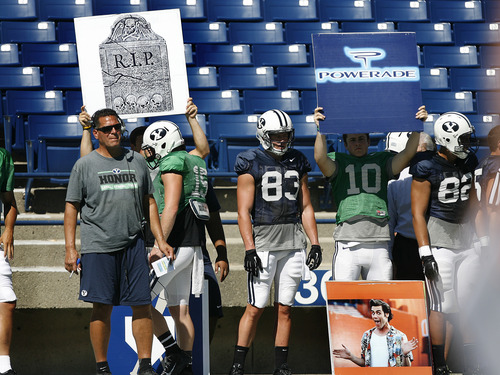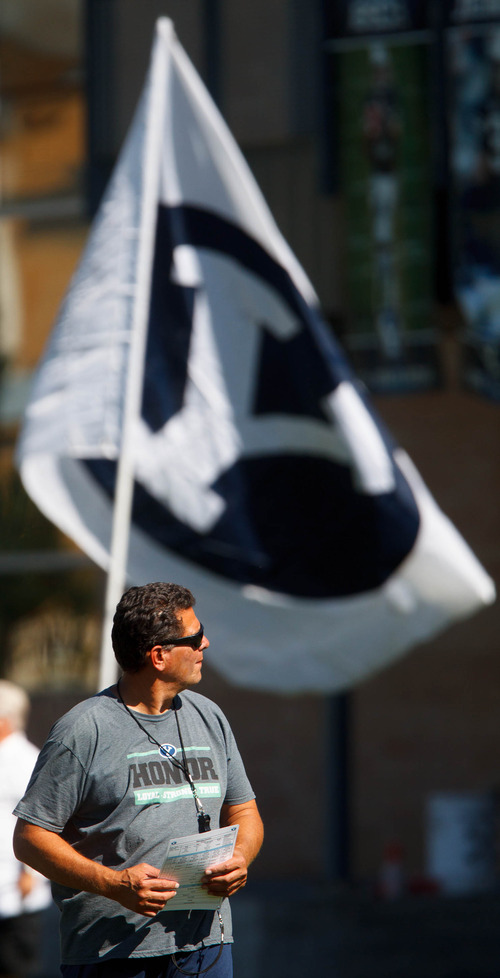This is an archived article that was published on sltrib.com in 2013, and information in the article may be outdated. It is provided only for personal research purposes and may not be reprinted.
Charlottesville, Va.
Other than the weather, the BYU Cougars could not have asked for a better environment to test their new offense.
The 89-degree temperature and 74-percent humidity for Saturday afternoon's kickoff at Scott Stadium will create some demanding conditions. The opposing defense is another story, which is why this visit to Virginia is an ideal season-opening scene for BYU's new offense.
The Cavaliers have just enough cachet as an Atlantic Coast Conference team to give some BYU some credibility for beating them, while lacking the defensive ability to keep that from happening. That's assuming the Cougars' offense is advanced enough at this stage of its development to sustain drives — not just "go hard, go fast" from the sideline to the field and back.
And there's just enough uncertainty about this subject to make this game intriguing. Ten months have passed since quarterback Taysom Hill was injured, ending his freshman season. Eight months have gone by since Robert Anae returned as BYU's offensive coordinator, part of undoubtedly the biggest overhaul of any phase of the campus operation in BYU history.
Ultimately, the offense's performance under this version of Anae's leadership is how BYU coach Bronco Mendenhall will be judged. If this Arizona-style, fast-paced approach really works, the Cougars will be on to something. If not, they're in for another season of just seeing how far Mendenhall's defense can take them.
What's clear at this point is that Anae is not the same coach who left BYU after the 2010 season, and this is not the same offense. Working at Arizona — especially, experiencing coach Rich Rodriguez's dynamic offense in 2012 — changed his entire outlook on offensive football.
"I was completely blown away," Anae said, "with how they viewed themselves as coaches and players and the mindset and culture that requires."
The Wildcats play fast, with a fairly simple scheme and relentless effort that reminded Anae of BYU's defense. Sometime during the 2012 season, he found himself thinking, "That would fit Bronco Mendenhall's staff, because it's exactly what he's doing on the defensive side of the ball. I got exposed to an offensive version of that."
It worked for Arizona, and Mendenhall needs it to work for BYU. Mendenhall was sufficiently dissatisfied with the offense and impressed with Anae to authorize the hiring of four other staff members, giving the offense an entirely fresh start.
Lance Reynolds retired and Mark Weber moved to Utah State before anything else happened, but it's probably fair to lump them in the same category as former offensive coordinator Brandon Doman, Joe DuPaix and Ben Cahoon, who lost their jobs in the transition. In came Garett Tujague, Guy Holliday, Mark Atuaia and Jason Beck, joining Anae. Those moves represent radical change, by BYU's standards.
Offensive statistics will measure the impact of Mendenhall's management. So will wins and losses, obviously. Yet there's also a subjective element in play, of having the defensive players embrace the offensive guys to mend the inevitable split that occurred last season, by Mendenhall's account.
That's why Anae said part of his job description is "to unite [Mendenhall's] team," with the offense working as hard and contributing as much as the defense. The offensive players get that.
"It was frustrating as an offense, just because the games we lost were because of us, because we couldn't score," said receiver Cody Hoffman. "And so we've taken that as a motivational factor. That's why we had to get a new coaching staff and change up our ways and our scheme."
In the heat of Virginia, the Cougars will try to validate those changes.







